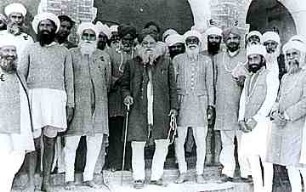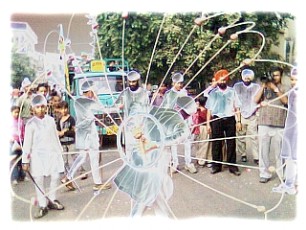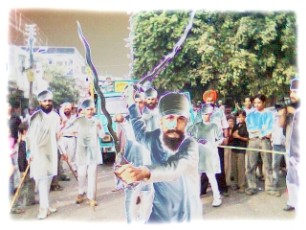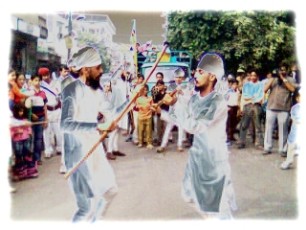namdhari world
Main menu:
- Home Page
- Kuka Faith
- History
- Sikh Gurus
- Namdhari Gurus
- Freedom Fighter - Satguru Ram Singh Ji
- Warrior of Peace
- Non-Cooperation Movement page 1
- Non-Cooperation Movment page 2
- Kuka Postal Service
- No Trial
- Battle for recognition as part of India's struggle for freedom
- Plaque at Ludhiana Railway Station
- Ram Singh Kuka by G.K.Venkateshamurthy
- Social Reforms by Satguru Ram Singh Ji
- Birth of Sant Khalsa
- Kuka Movement - by Film division of Government of India
- KUKA LEHAR - India's first war for independance (1856)
- Satguru Jagjit Singh Ji
- Contradictions
- Historical Quotes
- Vaisakhi - 1699
- Gurmukhi Script
- Sikh Women
- Knowlegde Bank
- Connections
- Places to visit
- Resources
- Music World
- Calendar
- Sports
- ETC...
Hola Mahalla
Calendar > Events
"HOLI the festival of colours has been a very distinct event in India since the times of Bhagat (Saint) PRAHALAD, the son of HARNAKASHYAP, who being a autocrat King, forced his countrymen to worship him, instead of God. The defiance of Prahalad led to many tortures given to him by the King, one of which was to be burnt alive. 'Holkan' a sister of Harnakashyap volunteered to take Prahalad into a flame of fire as she was in possession of some magical powers by which she was immune to fire. But Prahalad, with the Grace of God was spared and Holkan was destroyed by the same fire, she was not susceptible to. Since that day, this festival came into existence i.e. The Triumph of Truth over Evil.
The transformation of' HOLA MOHALLA from 'Holi was first perpetuated by Sri Guru Gobind Singh Maharaj, who in A.D. 1701 gathered Sikhs at Anandpur to hold the first Hola fair. In due course this festival was given an uplift with the inclusion of martial arts as one of its salient features. For Namdhari Sikhs, however, it has added significance, who celebrate it as a Tribeni-Sangam to mark the birth of Satguru Balak Singh Ji and Satguru Pratap Singh Ji.
Sri Guru Gobind Singh Ji divided his Army into two groups and made them fight mock battles - hence strengthening their military techniques and fighting abilities. Traditionally, the festival includes competitive displays of weaponry and symposia of poetry. Today Nihangs show off their martial skills at the Hola festival at Sri Anandpur Sahib, the home of "Hola Mohalla" of Guru Gobind Singh.
During and after the Sikh Raj the 'Hola Mohalla' took a different turn. The Sikhs indulged themselves in all kinds of vices and forgot the Gurus' teachings. This wretched state of the Sikhs (during and after the Sikh Raj) was witnessed by Sri Satguru Ram Singh Ji. The old 'Hola Mohalla' of Guru Gobind Singh was again re-enacted and resurrected by Satguru Ram Singh and at Anandpur the Hola Mohalla was celebrated with a record breaking attendance. (British records suggest that more than 10,000 sikhs accompanied the Guru to Anandpur). The festivities accomplished were to the standard of Guru Gobind Singh's time. Subsequently the festival became a very prominent item in the Namdhari calendar until A.D. 1872 when Satguru Ram Singh was exiled by the British to Rangoon and then to Margui.
After the exile of Satguru Ram Singh Ji, the British created conditions of of semi – captivity and made sure no large fairs took place. During this time the 'Hola' was never celebrated as a festival, until the relaxation of the British surveillance. Guru Hari Singh after a lapse of nearly 27 years, in AD 1898 celebrated the Hola in a village in Sialkot namely Guru Chak. Since that day the 'Hola' celebrations have been quite consistent until the present time.
Sri Satguru Ram Singh Ji turned this festival, having age-old background, into the mode to propagate and proclaim the Bhajan-bandgee, Katha-Kirtan and chalk out program of independence. Sri Satguru Hari Singh Ji advanced this tradition further. By grouping together the birth anniversary of Sri Satguru Balak Singh Ji and Hola, Sri Satguru Partap singh Ji made the festival more delightful. Hazra Hazoor Sri Satguru Jagjit Singh Ji made it Tribeni-Sangam – the convergence of three, by permitting celebrations of birth anniversary of Sri Satguru Partap Singh ji during this festival.
The festivities of the Tribeni-Sangam are performed for a period of four days, which include all kinds of religious programmes, concerts, exhibitions etc. Hollas were celebrated in various towns and cities, but today the holla is celebrated in all its style and vigour in Sri Bhaini Sahib.

Holla Mohalla 1958 (Sri Jivan Nagar): Akali leader Master Tara Singh and others attended.


